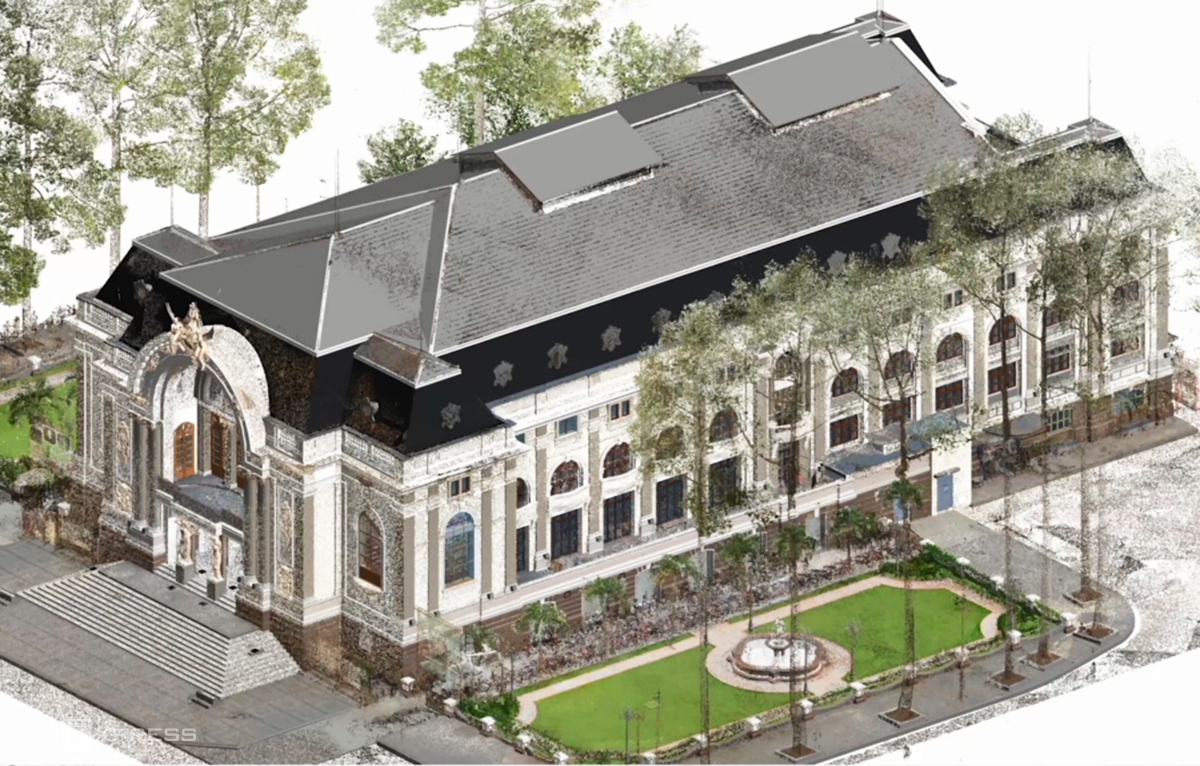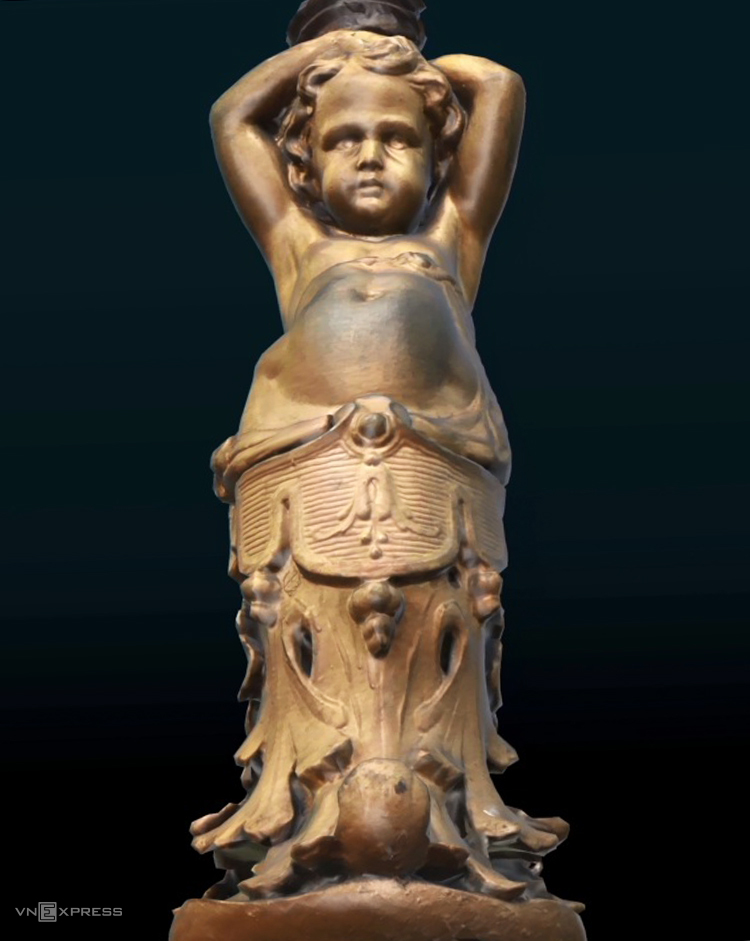(84 - 28) 62970345
Digitalizing the 120-year-old Saigon Opera House
The 120-year-old Saigon Opera House was laser scanned and merged with photos at over 350 scan stations. Then, over 1000 architectural details were digitalized for further maintenance and restoration in case of damage.
Built in 1898 and operated in 1900, Saigon Opera House obtained a unique design that prevailed in the late nineteenth century. All decorative patterns, façade reliefs and interior designs were entirely inspired by the French architectural style. With its original architecture along with modern sound and lighting systems, the Theater is a place where every crucial domestic and overseas performing arts show takes place, gradually becoming one of the City’s top-picked tourist attractions.

Over 21 years working at Saigon Opera House, Mr. Le Huu Luan – the former Director of the Center of the Performing and Cinema Organization, directly under the Department of Culture and Sports (the Theater management unit) - expressed his concerns towards any minor or major changes made to the theater. More to this, his concerns arose even more when the Metro Line was commenced operating 30 meters under the ground along with the severe fire of the Notre-Dame Cathedral in Paris, France.
Meanwhile, throughout over a century of operation, the Theater has inevitably degraded. In 2019, the building’s roofs developed long and serious cracks. Having acknowledged such dilapidations, Mr. Luan shared this to Mr. Pham Anh Tuan – the General Director of Portcoast Consultan Corporation. Upon receiving the information of preserving such historical and architectural values of the Theater, Mr. Tuan – an expert in the designing field - has made a promise to take on this tremendous responsibility.
In September 2019, after many discussions and surveys, the team produced a solution to digitalize the Theater’s whole area and architecture. About 30 engineers with more than a dozen laser scanners, geodetic measuring instruments divided themselves into groups of 5 to 7 people, then began conducting laser scanning at more than 350 scan stations, from the stage with the capacity of 400 seats to inaccessible areas such as the dome, the basement…

Outside the building, the crane with a reach of 20 meters was used to take the engineers and the machines up, for the scanning of the entire roofs and the outer walls. Moreover, the upper-storey balconies of the nearby hotels such as Caravelle and Continetal Hotel were used to scan the entire building.
At the end of the laser scanning procedure, the engineers digitalized and classified over 50 theater structural elements such as columns, roofs, purlins and bearing bars. In terms of the Theater’s architecture, the project team collected the data of 1,000 details comprising patterns, reliefs, statues, chandeliers,… in every corner of the theater, from the basement to the roof.
By recording the information of the Theater’s current state, engineers are able to collect the most accurate data of even the smallest structures, details, patterns with the deviation ranging from 1 to 3 mm, compared to the actual size. The digitalized details reflect technical specifications about the length, width, thickness, construction materials, historical signifcance,… As for such minor details, the engineers have to set up various scanning stations in order to precisely determine the object’s shape.
The final stage is transferring all the data into the computer-aided Building Information Modeling (BIM), allowing the history management of this 120-year Theater, even in the future. According to Dr. Hoang Hiep (the project leader), when it is necessary to reconstruct any parts and details, the Theater only needs to rely on the digitalized data. From that, the reconstruction phase is carried out by 3D printing the models, which will then be casted with high accuracy level, as close to the orginal. In early October, the digitalization project of the Theater was completed.

Mr. Pham Anh Tuan kept the overall cost of this digitalization project a secret as he regarded this as an act of expressing his gratitude to not only his friend but also to the preservation of ancient works in the city. Soon, the team will transfer all theater data to the theater management unit and the Department of Culture and Sports. Besides, this digitalization project is also in commensurate with
According to Architect Ngo Viet Nam Son, digitizing all ancient buildings to obtain current status drawings is necessary to manage and restore monuments and heritage when damaged. Some developed countries also apply the digitization of heritage because this model provides the highest accuracy of building information storage. However, the city should bid for digitization to choose technology that is reasonable and economical.
Today, besides Saigon Opera House, the city has more than 150 ancient villas, including 100-year-old building with architectural, artistic and cultural values that need to be preserved as Headquarter of the City People’s Committee, City Post Office, The Notre Dame Cathedral, Ho Chi Minh City Museum of Fine Art, etc.
In May, the City People’s Committee of Ho Chi Minh City classified the old villas into 3 groups 1,2, and 3 to facilitate the management and conservation. 52 villas in group 1 are strictly managed by the city government to keep the shape and architecture from outside to inside. About the villas in group 2, they need to keep the exterior architecture; group 3 has to comply with the regulations on planning, architecture and construction legislation.
According to the inspection conclusion of the Department of Construction, the villas of groups 1 and 2 cannot be demolished if they are not badly damaged or in danger of collapsing. In case of forced demolition to rebuild, the owner must comply with the original architecture, use the right materials, construction density, number of floors, villa height.
Mr. Vo Trong Nam, Deputy Director of the Ho Chi Minh City Department of Culture and Sport said that after receiving the digital data of the Ho Chi Minh City Theater, the Department of Culture and Sports will plan to apply this technology to the famous area of the city.
Portcoast Digital Transformation Center
We provide digital conversion services in the construction industry. We research ways to apply digital conversion to the world of design and construction, creating a digital platform to optimize design, promote industrial construction processes, and use digital models.
Contact Us
328 Nguyen Trong Tuyen Str., Ward 2, Tan Binh Dist. , Ho Chi Minh City
(84 - 28) 62970345; 62970341
portcoast@portcoast.com.vn